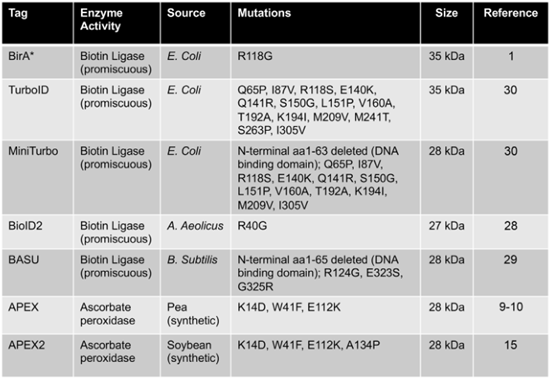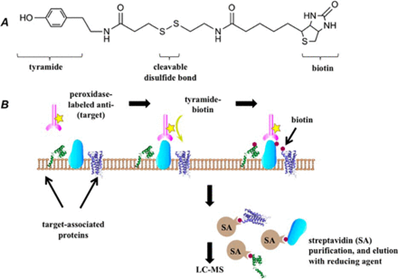相互作用蛋白质组学 (Interaction proteomics) #235
邻近标记(Proximity labeling, PL)是一种标记与感兴趣蛋白(POI)邻近的蛋白质(或RNA)的技术。
PL 的开发是为了提供一种与传统方法(AP-MS, Y2H)互补的方法,用于研究活细胞中的蛋白质相互作用。PL 通过基因工程,将工程酶与感兴趣的蛋白融合。PL 酶将惰性小分子底物转化为短寿命的活性物质,例如 APEX 中的自由基或 BioID 和 TurboID 中的活化酯(activated ester),这些物质从酶活性位点扩散出去,与邻近的内源性物种共价标记。
过氧化物酶和生物素连接酶产生的活性物质也是不透过膜的 [10.1126/science.1230593]。
底物分子通常包含一个生物素手柄,以便随后使用链霉亲和素珠子富集标记物种,并通过质谱(对蛋白质)或核酸测序(对 RNA)进行鉴定。
根据 PL 酶的定位和表达,PL 可用于在不同的长度尺度上研究空间蛋白质组——从整个细胞到细胞器和亚细胞室,再到大分子复合物。
Conceptually related technologies
- Proximity labeling catalyzed by genetically encoded enzymes
- Proximity ligation assays on fixed cells with antibody or nucleic acid probes
- Photocrosslinking with unnatural amino acids
- Promiscuous enzymes that label with non-diffusible substrates (for example, PUP-IT)
标记半径
标记半径由活性物质的半衰期和环境中的猝灭剂浓度决定,例如 APEX 中的谷胱甘肽和 BioID 及 TurboID 中的胺。
实验测定的 HRP、APEX、BioID 和 TurboID 酶的标记半径在活细胞中为 1–10 纳米 [10.1038/nbt.2375][10.1073/pnas.1406459111]。
然而,与其说是一个固定的半径,不如将 PL 酶的标记想象为一个“等高线图”(contour map),其中反应物浓度在 PL 酶处最高,并从源头逐纳米递减。
- BioID: ca. 10 nm [10.1073/pnas.1406459111]
- HRP: 269 ± 41 nm [10.1073/pnas.2203027119]
- APEX: ca. 20 nm [10.1038/nbt.2375]
- µMap-based labeling: ca. 54 ± 12 nm [10.1073/pnas.2203027119]
Extracellular PPI profiling
- µMap
- Extracellular TurboID (ecTurboID) [10.1126/scisignal.adl6164]
分类

By catalyst
- Enzyme
- peroxidases (engineered ascorbate peroxidase 2, APEX2; horseradish peroxidase, HRP; split enzymes)
- biotin ligases (BioID, BioID2, BASU, TurboID, miniTurbo)
- Organocatalyst
- light-activated chemical catalysts (μMap)
By proximity method
- Protein fusion
- Antibody-targeted
- Ligand-directed
BirA*
Kyle J. Roux*. J Cell Biol. (2012)

Due to its slow kinetics, BioID requires 18–24 hours of reaction time to obtain sufficient labeled material for proteomics.
TurboID
Alice Y. Ting*. Nat. Biotechnol. (2018).
BioID2
Kyle J. Roux*. MBoC (2016).
BASU
Paul A Khavari*. Nat Methods (2018).
APEX

H2O2 delivery could lead to undesired cytotoxicity arising from oxidative stress signaling.
Alice Y. Ting*. Nat Biotechnol (2012);
Alice Y. Ting*. Science (2013).
APEX2
Alice Y. Ting*. Nat Methods (2015).
HRP-based
Sarah Perrett*; Antony P. Jackson*. J. Biol. Chem. (2014).
Antibody-based targeting:
SPPLAT (selective proteomic proximity labeling using tyramide)

Francis S Collins*. Nature Methods (2018).
proteomic analysis of surface IgM-class B cell receptor (BCR) cluster
Biotinylation by Antibody Recognition
Samples are fixed, permeabilized, and stained with the desired primary antibody and species-specific HRP-conjugated secondary antibody
Incubated with biotin-phenol
biotinylation reaction induced by brief exposure to H2O2.
光催化近程标记
David MacMillan. Science. 2020